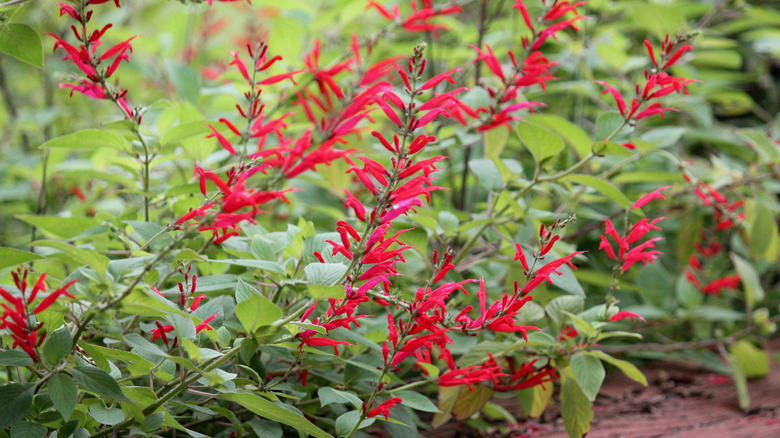Hummingbirds, butterflies, and other pollinators can be some of the most welcome guests in any garden or yard. They do a valuable service of helping things grow and are also fun and relaxing to enjoy as they visit plants and flowers. Many gardeners choose their planting with an eye toward attracting these tiny local residents, offering up flowers and plants that are especially enticing. Pineapple sage (Salvia elegans) is one such plant whose sweet, distinctive scent and scarlet red flowers attract various birds and insects, including hummingbirds and many different butterflies.
A member of the mint family, pineapple sage is known most for its scent that closely resembles pineapple, making it an especially fragrant addition to your yard and a fun addition to fruity beverages and dishes. With its origins in Central and South America, it’s known as a perennial in more temperate climates, but an annual in colder ones. Many gardeners plant it year after year for its beauty and scent.
Growing pineapple sage

Pineapple sage can grow anywhere from 3 to 4 feet tall and wide, with perennial plants in warmer climates growing the largest. It is most hardy in USDA zones 8-11. In more temperate places that lack temperatures cold enough to frost, it will often go dormant and return in the spring, though in tropical zones, it sometimes blooms all year. Other factors may contribute to the timing and proliferation of blooms, including temperature, moisture, and light from artificial sources like streetlamps. Ideal growing conditions include both morning and afternoon sun.
Pineapple sage grows best in moist but well-drained soil. For new plants, a mix of native soil and composted organic material produces the best results. While regular watering is good for the plant at first, eventually it will only need additional watering during dry spells or droughts. Plant your pineapple sage plants 2 to 3 feet apart. They also can be potted to be moved inside in places with harsher winters. While they mostly attract wanted guests, pineapple sage can occasionally be vulnerable to pests like mealybugs, spider mites, and aphids.
Benefits of pineapple sage
While gardeners can enjoy its yellow-green, slightly fuzzy leaves for much of the year, the flowers typically bloom late in the season, which makes them a perfect meal for hummingbirds and butterflies as other pollinating plants begin to slow down production in preparation for fall. In warmer climates, pineapple sage will continue to bloom through the autumn, offering food for migrating insects and birds, particularly hummingbirds, who are especially attracted to tube-shaped flowers that are a vivid red (which coincidentally, is a color known to attract hummingbirds). Sulfur butterflies, like the cloudless sulfur, also seem to appreciate pineapple sage.
For humans, the flowers and leaves are edible and often used in salads and teas. Because of their resemblance to pineapple (they smell and taste sweet and fruity), they make a great addition to fruit salad and in jams or jellies or an addition, ground or whole, to summertime cocktails. They also make a beautiful bouquet in the summer or early fall that retains a pineapple-like scent after cutting.